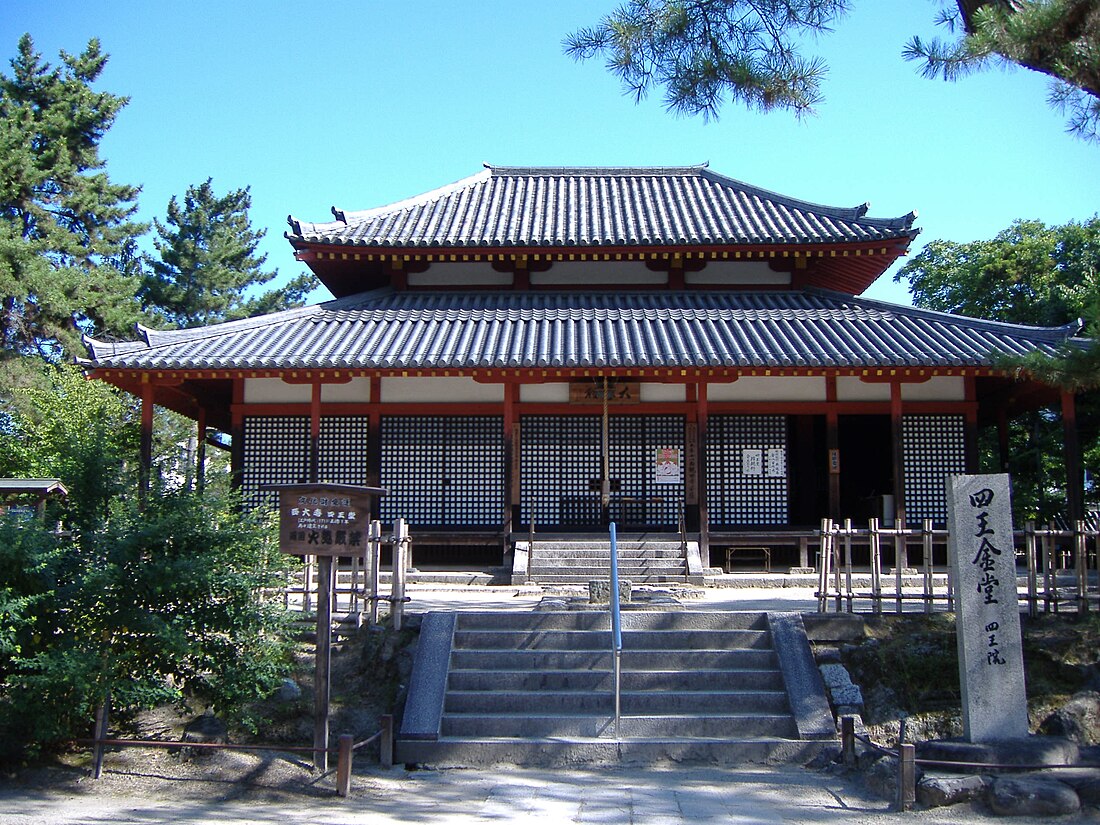Top Qs
Timeline
Chat
Perspective
Shingon Risshu
Sect of Japanese Buddhism From Wikipedia, the free encyclopedia
Remove ads
Shingon Risshū (真言律宗; "Shingon-Vinaya School") is a sect of Japanese Buddhism that integrates the pratimoksha rules, the ordination precepts of Early Buddhism (also called Root Buddhism), and the samaya rules of Vajrayana, all grounded in Shingon Buddhism's esoteric doctrine. It is noted for reviving the spirit of the Risshū sect, one of the Six Schools of Nara Buddhism (南都六宗).

The sect emphasizes adherence to the vinaya—the Buddhist monastic discipline—more than traditional Shingon Buddhism, while retaining tantric practices. Its home temple is Saidaiji Temple in Nara City.
Remove ads
Founder
The sect was founded in the 13th century by the monk Eison (叡尊; also known as Kosho Bosatsu), a disciple of Jōkei. Eison held Kūkai (the founder of Shingon Buddhism) in high reverence and established a synthesis between the Shingon and Risshu traditions. His efforts were continued by his eminent disciple Ninshō (忍性; also called Ninsei).[1]
History
Summarize
Perspective
Kamakura Period
Reacting to the decline in monastic discipline, Eison and Ritsu monk Kakumori began personally administering the ordination precepts, bypassing the imperial state's monopoly on ordination procedures (自誓受戒, jisei-jukai). Eventually, Eison and Kakumori parted ways due to differing interpretations of the precepts.
Eison proceeded to rebuild major temples including Saidaiji, Kairyuoji, Hokkeji, and Hannya Temple, reestablishing strict vinaya observance independently from the Imperial Court.[2]
His disciple Ninshō expanded the reach of the movement by founding Gokurakuji in Kamakura and engaging in active lay outreach. This marked the birth of the Shingon Risshū, which was initially seen as a reform within Shingon and Ritsu traditions, later recognized as a new school within what is now termed "Kamakura Buddhism".
Eison’s successors, such as Shinku and Shinsei, earned the trust of the court and helped expand the sect by restoring local Kokubunji temples and converting them into branch temples. At one time, the Ritsu sect (including Shingon Ritsu) rivaled the Zen and Jōdo sects in influence. However, Nichiren criticized it as a "Ritsu national pirate" (律国賊).
Eison and Shinsei also engaged in extensive social welfare work, aiding the poor, the sick, and especially leprosy patients. Tens of thousands were reportedly helped. The repulsion of the Mongol (Yuan) invasions (Genkō War) was partly attributed to the protective incantations performed by Eison and Ninshō.[3]
After Muromachi
The sect declined temporarily during the late Muromachi period, but it was revived in the early Edo period by Meinin. His student Jōgen was the first to use the name "Shingon Ritsu-shū" publicly.
In 1872 (Meiji 5), the Meiji government reorganized Buddhist schools, merging all Ritsu sects into the Shingon sect, citing Shingon Risshū’s Shingon lineage. However, independence movements arose within Ritsu temples.[4]
Led by the 64th Elder Saeki Kōsō, Saidaiji Temple spearheaded the push for autonomy. In 1895 (Meiji 28), the Ritsu sects regained independence, and Shingon Risshū was reestablished as a separate sect. Some temples remained within Shingon, however.
Since then, Saidaiji has served as the head temple of the Shingon Risshū, and its chief priest customarily serves as the sect’s chief abbot.
Remove ads
Elders of Saidaiji
- Kosho Bodhisattva Eison
- Jishin Wajo Shinku
- Senyu
- Shizun
- Kengen
- Choshin
- Shinsho
- Genyo
- Shintan
- Seisan
- Kakunjo
- Teiyu
- Shinzon
- Gyoki
- Teisen
- Zenyo
- Jicho
- Shinsen
- Ryoyo
- Kozan
- Ekuu
- Einyu
- Eigen
- Genku
- Eishu
- Kohai
- Ryosei
- Genshou
- Kousan
- Sen'e
- Shunyo
- Ryokei
- Sonkai
- Takachu
- Takamori
- Genkai
- Takami
- Kojun
- Kaju
- Sonju
- Kōkō
- Sonkei
- Gokai
- Kōshū
- Takahisa
- Kosen
- Sonchi
- Kōki
- Kenyu
- Kōen
- Sonshin
- Kōsan
- Songaku
- Son'ei
- Kankei
- Kōyu
- Sonsei
- Sondō
- Sonin
- Keihan
- Eido
- Son'e
- Sonkai
- Kohan
- Saeki Hirochō
- Fukugaki Shin’ō
- Saeki Goryū
- Komaoka Jōen
- Toshiaki Segi
- Matsumoto Jitsudō
- Mitsuaki Taniguchi
- Jitsuen Ōya
- Taka Matsumura
Denominational organization
- President
- Director General
- General Affairs Department
- Finance Department
- Department of Teaching and Learning
- Director of Religious Assembly
- Religious Council Members (10)
- Chairman
- Vice Chairman
Temple ranks
- Head Temple – Saidaiji Temple, Nara City
- Daihonzan – Hozanji Temple, Ikoma City, Nara Prefecture
- Bekkaku Honzan – Ichinomuroin, Gokokuin, Shomyoji (Yokohama), Kyokoji (Osaka), Kushokuen (Hirakata), Iyo Kokubunji (Imabari), Hokkeji (Imabari), Rengein Birth Temple (Tamana City, Kumamoto)
- Yugyoji – Gokurakuji Temple (Kamakura), Hoshoin (Uji), Iwafune Temple (Kizugawa), Joruridera Temple (Kizugawa), Kairyuuji Temple (Nara), Fugakuji (Nara), Hannya Temple (Nara), Genkoji (Nara), Kotouin (Nara), Shirahoji Temple (Nara), Nokuan Temple (Yamatokoriyama)
- Other Temples – Chogyumi-ji Temple, Chofukuji, Enshoji Temple (all in Ikoma)
Remove ads
Educational institutions
- Koho Academy
- Tanechiin University (co-managed)
- Rakunan High School and Junior High School (co-managed)
- Shingon Ritsu Institute of Religious Studies
References
Wikiwand - on
Seamless Wikipedia browsing. On steroids.
Remove ads
